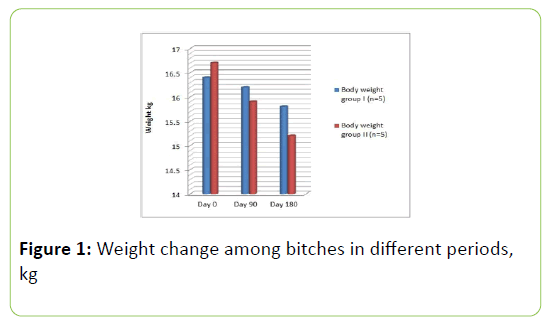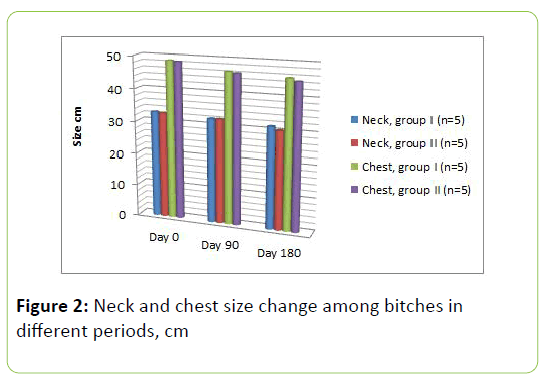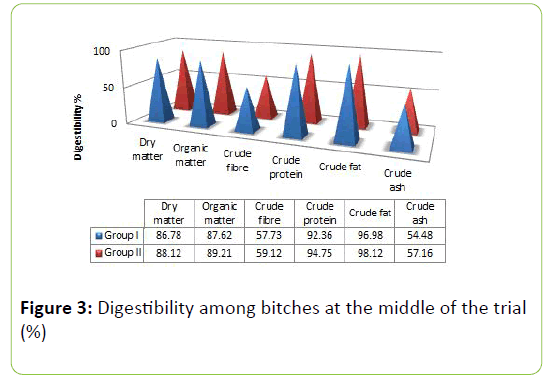Can Dynamically Micronized Clinoptilolite Improve the Quality of Life, For Senior Beagle Dogs with Obesity
Lina Skinke, Algirdas Januskevicius
DOI10.21767/2572-5459.100041
Lina Skinke* and Algirdas Januskevicius
Department of Animal Breeding and Nutrition, Veterinary Academy, Lithuanian University of Health Sciences, TilÃÆââ¬Â¦ÃâþÃÆââ¬Å¾Ãâââ¬âs 18, LT-47181 Kaunas, Lithuania
- *Corresponding Author:
- Lina Skinke
Department of Animal Breeding and Nutrition
Veterinary Academy, Lithuanian University of Health Sciences
TilÃÆââ¬Â¦ÃâþÃÆââ¬Å¾Ãâââ¬âs 18, LT-47181 Kaunas, Lithuania
Tel: +37061209822
E-mail: lina.skinke@lsmuni.lt
Received date: January 22, 2018; Accepted date: February 12, 2018; Published date: February 18, 2018
Citation: Skinke L, Januskevicius A (2018) Can Dynamically Micronized Clinoptilolite Improve the Quality of Life, For Senior Beagle Dogs with Obesity. J Anim Res Nutr Vol No 3: Iss no: 1: 3.
Copyright: © 2018 Skinke L ,et al. This is an open-access article distributed under the terms of the Creative Commons Attribution License, which permits unrestricted use, distribution, and reproduction in any medium, provided the original author and source are credited.
Abstract
Obesity is one of the most often met nutritional disorders among pets. Usually it is defined as: “a condition of positive energy balance and excessive adipose tissue formation with adverse effect on morbidity and mortality”. There are many factors influencing growing risk: living indoors, inactivity, middle or senior age, being neutered and being of mixed breeding, as well as many dietary factors.
The success of obesity management a lot depends on the owner. Most often obesity is being controlled in two ways: dietary restrictions or physical activity. Today we can find many commercial ready to use obesity diets for dogs on the shelf’s in a veterinary clinic. Veterinarians together with pet owners can try to manage the obesity by choosing best suitable way for certain pet. But when it comes to older dogs and especially females to achieve visible results might be complicated and this is the reason why we decided to prove the efficacy of clinoptilolite to the weight reduction for older Beagle females.
Keywords
Nutrition; Obesity; Overweight; Antioxidants; Veterinary
Introduction
Correct nutrition plays an important role in the welfare of older people as well as animals. Elder pets have higher requirement for some nutrients and much lower requirement for others. The minimum requirements for senior dogs are based under the level of adults. Usually we see lowered level of proteins, decreased quantity of phosphorus and sodium, increased fiber and additives like omega-3, natural antioxidants and other supplements added, when we speak about diet for senior dogs [1].
There is no official statistics, but some articles shows, that 68% of humans are overweight around the world [2]. It is estimated that 55% of dogs and 53% of cats are overweight and the prevalence of combined overweight and obesity in domestic canine population is in the range between 23-41% [3-5]. It was founded a significant relationship between the degree of overweight of dogs and the body mass index of their owners [6]. Today obesity is one of the leading health treat in pets and the major cause of death as well as the most prevalent nutritional disorder in small animal practice [7-9]. To control and prevent obesity, nutritional and physical activity or settlements have been common factors employed [1]. Regular physical activity can improve health and owners are advised to exercise their dogs on a regular basis [10]. Obesity is thought to affect quality of life, but limited objective data exist to support this supposition [11].
Obesity is defined as “a condition of positive energy balance and excessive adipose tissue formation with adverse effect on morbidity and mortality” [12]. Definition of overweight has been suggested for dogs as an excess of 15% and obesity over 30% of the ideal body weight [3,13]. Effective obesity prevention and treatment require a better understanding of owner attitudes on nutrition and feeding habits so that programs can be tailored to the individual owner and animal [14]. There is no one diet and no one supplement, which works for every pet.
What is Old? The point at which a dog progresses from adult to a senior or geriatric life stage is variable and subjective. Life expectancies vary widely among dogs depending on breed and body size. The American Animal Hospital Association (AAHA) Senior Care Guidelines suggest that, with the exception of largebreed dogs, most dog breeds reach middle age by 7 to 8 years of age and should be considered seniors when they reach the last 25% of the predicted life span for their breed. Beagle dogs are considered to be seniors at the age 8 or above [12]. Life stage categories are somewhat arbitrary and vary depending on the source [15].
Developing minimal and adequate nutrient requirements has big potential to contribute the optimizing body composition during aging, preventing nutrient deficiencies and improving the quality of life for older dogs. Therapeutic diets have been used for over 50 years to help manage obesity and overweight status in dogs [16,17].
Factors that contribute to obesity of dogs are classified into three main categories: genetic pre-disposition, reproductive management, dietary/exercise management [18].
Neutered dogs may have positive effect to lead to be obese, possibly as a result of a reduced metabolic rate [19,20]. In general obesity in dogs is more often recognized among females than males [21].
There are very few studies, evaluating the effect of Zeolite- Clinoptilolite to the dogs having overweight or obesity problems. Zeolite means, “Boiling stone” and was discovered in 1756. Nowadays, there are more than 40 natural zeolite minerals and more than 150 synthetic zeolites known. Clinoptilolite is one of natural zeolites and most often used for agricultural activities. The zeolite mineral has a large isomorphic place changing capability. Because of this reason zeolite has a high cation changing capacity and the characteristics of being selective at the cation absorption.
Objectives
The aim of the study was to proof the efficacy of dynamically micronized clinoptilolite into the weight loss of the senior Beagle females. Beagle females were divided into 2 groups: fed just pure dry commercial senior dog diet and fed the same diet with additional amount of clinoptilolite. The results of research showed, that more visible weight loss were founded in the groups that got additional amount of clinoptilolite.
Materials and Methods
Research was made with 10 Beagle bitches and the same number of voluntary owners, using the support of 2 veterinary clinics. Two female groups of 5 dogs in each were selected for a trial to control the metabolism and dietary efficacy. This research was carried out for 6 months in a row.
Dog owners gave permission for their data to be used, in fully anonymized forms (any client identifying data was removed) and for the results to be publicized if needed. To be eligible for inclusion in the data analysis part of the study, dogs had to be senior and female (≥8 years of age). Each owner was asked to complete questionnaire information once a month about the satisfaction, fullness of the pet, willingness to eat food and firmness of the stools, as well as to visit veterinary clinic to check out the status and performance. Weighting of the dogs and body measurements were done three times at the veterinary clinics: at the beginning, at the middle (90 days) and at the end of the trial (at 180 days).
Before the trial owners completed survey about their pet, feeding habits, importance of pet nutrition for senior dogs. Was several questions related to feeding habits as: type of diet fed (home-made, commercial dry, commercial canned or any other). Also quantity and kind of table food given, frequency of the meals, treats given or not before the trial per day. Owners as well were asked: how much do they know about the aging of the pet and the changes after they become senior (full survey of the owners available upon request).
Before the trial all dogs were fed homemade diet. During the trial dogs were separated in to two groups: first group-fed commercial dry balanced mature adult diet food with chicken and rice and second fed the same dry balanced mature adult food adding 1.5% dynamically micronized clinoptilolite (calculated from the amount of dry food fed per day). All dogs were fed twice a day: dividing daily portion into equal parts (breakfast at 7 am, dinner at 7 pm).
All dogs were healthy (6 females of 10 were neutered) with exception of obesity. Body condition score (BCS) was assessed using a 9-point scale [22]. Selected Beagle females were in the level of BCS between 6 and 8.
Statistical results: All statistical analyses were performed with the statistical software package SAS. Descriptive statistical analysis included the calculation of means, SDs, and proportions.
Results
Dogs were between 10 and 12 years old. 7 bitches were living in the city (going outside 2 times a day for 5-10 min) and 3 bitches were living in the suburb going outside as well twice a day, but spending 10-15 min. All dogs were fed home-made food, received canine snacks and leftovers of table scraps before the trial.
Was not easy task to switch 100% to dry food and skip all treats, but once it was implemented owners noticed positive results very soon: 40% of females stopped asking food from the table after 2 weeks, 50% after 4.5 weeks and 10% continue doing it during the trial.
Stools were more firm and turned to the grade 2-2.5 from previously being 3-3.5, evaluating by the “Waltham faeces scoring system”.
Among two selected groups: without clinoptilolite and with clinoptilolite we see very clear positive efficacy of the clinoptilolite zeolite. During the period of six month the difference in weight loss was 5.39 per cent, between two groups as shown in the Figure 1.
Biggest reduction of the neck and chest sizes was founded among the bitches in the group II as well and proved us the efficacy of added zeolite to the food (Figure 2).
During all six months as well was measured the digestibility coefficient of the food. By investigating chemical analysis of stools, we discovered, that bitches in a group II (with additional quantity of clinoptilolite) performed more firm stools and better results in weight reduction comparing with the group I. Percentage of organic matter at the group II, was higher by 1.82%. We found 57.73% of crude fiber in the control group (without clinoptilolite), when in group with additional clinoptilolite we found 59.12%. Crude proteins were higher by 2.61% at the Group II as well. Crude fat and crude ash performed the same direction, when crude fat was 96.98% at the control group and 98.12% at the group II and crude ash at the group II, was higher by 4.89% comparing with the group I as in the Figure 3.
Discussion
Canine obesity is considered as one of the major health problems in many European countries for its contribution to the development of diseases, as well as decreased lifespan of the dogs. Several studies have been published reporting the prevalence of the pet obesity in different countries like England, France, Spain and others. However, so far no studies have been reported evaluating the efficacy of clinoptilolite in weight reduction for senior bitches.
Lack of nutritional knowledge, such as not knowing basic things about food ingredient requirement for senior dogs and changes of quantity of calories fed per day gives the answer, why did the dogs gain unexpected weight so often. Only 2 owners out of 10 were aware about information like: at what stage Beagles turn to senior age and how it affects the body, what changes must be done if there is a wish to avoid extra weight and obesity.
Several studies shows, that the only variable independently associated with BCS was neuter status. This is not surprising since neutering is associated with an increase in appetite and a decrease in calorie requirements. Therefore, if veterinarians do not give specific instructions to reduce animals’ calorie intake at the time of neutering or if owners are non-compliant, animals will be at higher risk for the development of overweight and obesity [10]. Pet owners had very limited information about neutering correlation with obesity.
In this study Beagle bitches performed the results, where we see that at group I they lost 1.22% of body weight during first 3 months and 3.60% during all trial period (6 months). While females at group II lost 4.91% at first period and 8.99% of body weight during second period (6 months). Measuring neck and chest: better results performed bitches in the group II. Difference between two groups was quit visible. Neck size of first group (without additional clinoptilolite) was 4.87% smaller during 6 months and second group improved by 7.34% during the same period. Chest measurements: for the first group was 6.37% loss in the period of 6 months and at the group II, the bitches reduced chest size by 7.63%.
Conclusions
Research showed, how much does the efficacy of weight loss depends on the diet itself and additional ingredients as clinoptilolite for mature/senior dogs. We can make the conclusion, that if the owner wants to have close relations with the pet longer it is very important to take care of the dogs and do not let him become obese. Once it happens, adding 1.50% dynamically micronized clinoptilolite (calculated from the daily meal) to the dry senior food, showed easier and more effective way to weight reduction of the pet.
Future directions and recommendations
Dynamically micronized clinoptilolite can be successfully use for weight reduction of dogs, by giving its superiority in terms of faster and better results, cost and effectiveness, when compared to pure, commercial prepared pet food. This report has only investigated the weight, neck sizes and chest size loss as well as improvement of digestibility for senior Beagle bitches. Other breeds and ages were not participating in the research and it is recommended that these factors be assessed.
In addition, this report recommends further work to:
1. evaluate possibility and efficacy to use product for other breeds;
2. investigate the results of using product for different ages;
3. discover if product is effective in weight reduction for other pets;
4. make an assessment of the market demand of this product and find supplier.
References
- Hutchinson D, Freeman LM, Schreiner KE, Terkla DG (2011) Survey of opinion about nutrition requirements of senior dogs and analysis of nutrients profiles of commercially available diets for senior dogs. Intern J Appl Res Vet Med 9: 68-79.
- German AJ (2006) The growing problem of obesity in dogs and cats. J Nutr 136: 19405-19465.
- Lewis SD, Lewis LD, Morris M, Hand MS (1967) Small animal clinical nutrition III, Topeka KS: 639-643.
- Rossmeisl M, Jelenik T, Jilkova Z, Slamova K, Kus V, et al. (2009) Prevention and reversal of obesity and glucose intolerance in mice by DHA derivatives. Obesity (Silver Spring) 17: 1023-1031.
- Simpson JW, Anderson RS, Markwell PJ (1993) Clinical Nutrition of the Dog and Cat. Oxford, Boston, Blackwell Scientific: 56-95.
- McGreevy PD, Thomson PC, Pride C, Fawcett A, Grassi T, et al. (2005) Prevalence of obesity in dogs examined by Australian veterinary practices and the risk factors involved. Vet Rec 156: 695-702.
- Crane SW (1991) Occurrence and management of obesity in companion animals. J Small Animal Pract 32: 275-282.
- German AJ, Holden SL, Wiseman-Orr ML, Reid J, Nolan AM, et al. (2012) Quality of life is reduced in obese dogs but improves after successful weight loss. Vet J 192: 428-434.
- Jeusette IC, Detilleux J, Shibata H, Saito M, Honjoh T, et al. (2005) Effects of chronic obesity and weight loss on plasma ghrelin and leptin concentrations in dogs. Res Vet Sci 79: 169-175.
- Sapowicz SA, Linder DE, Freeman LM (2016) Body condition scores and evaluation of feeding habits of dogs and cats at a low cost veterinary clinic and a general practice. ScientificWorldJournal 2016: 1901679.
- Colliard L, Ancel J, Benet JJ, Paragon BM, Blanchard G, et al. (2006) Risk factors for obesity on dogs in France. J Nutr136: 1951-1954.
- Churchill JA (2015). Nutrition for senior dogs: New tricks for feeding old dogs. Critical Updates on Canine and Feline Health.
- Hedley AA, Ogden CL, Johnson CL, Carroll MD, Curtin LR, et al. (2004) Prevalence of overweight and obesity among US children and adults. Jama 291: 2847-2850.
- German AJ, Blackwell E, Evans M, Westgarth C (2017) Overweight dogs exercise less frequently and for shorter periods: results of a large online survey of dog owners from the UK. J Nutr Sci 6: 1-4.
- Willems A, Paepe D, Marynissen S, Smets P, Van de Maele I, et al. (2017) Results of Screening of Apparently Healthy Senior and Geriatric Dogs. J Vet Intern Med 31: 81-92.
- Robertson ID (2003) The association of exercise, diet and other factors with owner-perceived obesity in privately owned dogs from metropolitan. Perth, Western Australia. Prev Vet Med 58: 75-83.
- Roudebush P, Schoenherr WD, Delaney SJ (2008) An evidenced-based review of therapeutic foods, owner education, exercise, and drugs for the management of obese and overweight pets. J Am Vet Med Assoc 223: 717-725.
- Bland IM, Guthrie-Jones A, Taylor RD, Hill J (2009) Dog obesity: Owner attitudes and behavior. Prev Vet Med 92: 333-340.
- Edney ATB, Smith PM (1986) Study of obesity in dogs visiting veterinary practices in the United Kingdom. Vet Rec 118: 391-396.
- Root Kustritz MV (1999) Early spay-neuter in the dog and cat. Vet Clin North Am Small Anim Pract 29: 935-943.
- Andersen GL, Lewis LD (1980) Obesity in Current Veterinary Therapy pp: 1034-1039.
- Laflamme D (1997) Development and validation of a body condition score system for dogs. Canine Pract 22: 5-10.

Open Access Journals
- Aquaculture & Veterinary Science
- Chemistry & Chemical Sciences
- Clinical Sciences
- Engineering
- General Science
- Genetics & Molecular Biology
- Health Care & Nursing
- Immunology & Microbiology
- Materials Science
- Mathematics & Physics
- Medical Sciences
- Neurology & Psychiatry
- Oncology & Cancer Science
- Pharmaceutical Sciences



